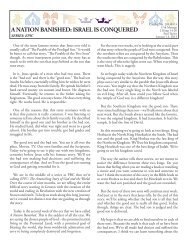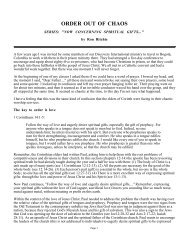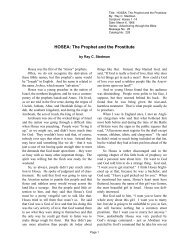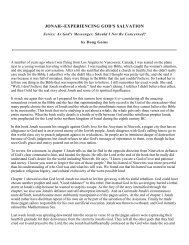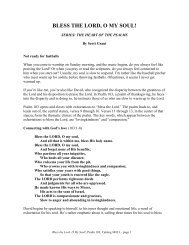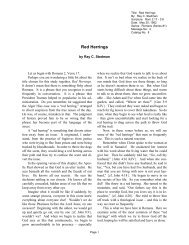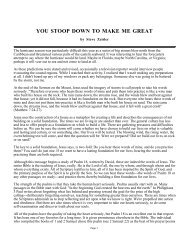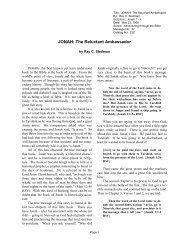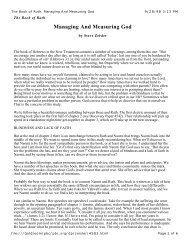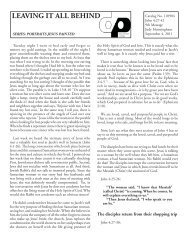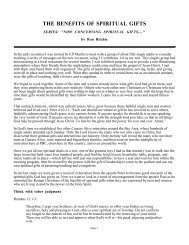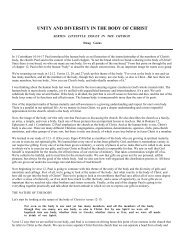Basics of Bible Interpretation - RayStedman.org
Basics of Bible Interpretation - RayStedman.org
Basics of Bible Interpretation - RayStedman.org
Create successful ePaper yourself
Turn your PDF publications into a flip-book with our unique Google optimized e-Paper software.
33. What do you think happened to him? Why?<br />
34. Now think again! What part does the information contained in verses 15-18 play in Paul’s<br />
word <strong>of</strong> encouragement to Timothy?<br />
Chapter Two<br />
Read chapter 2 (5-10 times.)<br />
1. The New American Standard <strong>Bible</strong> divides the chapter into two paragraphs; 1-13 and 14-26.<br />
Do you think this arrangement is valid?<br />
2. Observe the main verbs in chapter 2. You will note again, as in chapter 1, that most <strong>of</strong> them<br />
are commands. Mark the imperatives in your <strong>Bible</strong> in some conspicuous way.<br />
3. Note that the second word in verse 1 is the conjunction “therefore.” Remember that this term<br />
introduces a conclusion or inference (cp. 1:8). The action <strong>of</strong> the verb is based on some prior<br />
fact. On what basis, then, is Timothy to be strong?<br />
4. What further incentive to “be strong” is contained in the verse itself?<br />
5. Why are these two incentives so important in Timothy’s case?<br />
6. Verse 2 also begins with a conjunction, “and.” What does this connective suggest concerning<br />
the action <strong>of</strong> the two commands in verses one and two?<br />
7. Recall Timothy’s nature. What was he naturally inclined to do?<br />
8. How many generations are envisioned in verse 2?<br />
9. What pattern <strong>of</strong> ministry is established in this verse?<br />
10. What characteristic is Timothy to look for in those to whom he is ministering?<br />
11. Assuming that you “entrust” the truth to one faithful individual each year and equip that<br />
person to reach one more each succeeding year and the process continues unbroken for<br />
twenty years how many will be reached?<br />
12. The second command in this chapter is found in verse 3, “suffer hardship with me.” Read<br />
2:3-13 again. How does Paul develop his argument? Are there any repeated words or ideas<br />
that indicate the theme <strong>of</strong> these verses?<br />
13. Again, what does this teaching suggest about Timothy’s natural inclination toward his<br />
assignment in Ephesus?<br />
14. Paul uses three illustrative metaphors in this section. What are they and what specific<br />
attribute does each one illustrate?<br />
15. Note that in each case there is a responsibility and a reward. What are they?<br />
16. Verse 7 contains a command and a promise that ought to encourage you on in your study!<br />
17. Verse 8 contains another command “Remember Jesus Christ.” Why does he insert this<br />
statement at this point in the argument?<br />
18. Note the order <strong>of</strong> the Lord’s names. Is this Paul’s normal order in this book?<br />
19. (Use a concordance and note occurrences <strong>of</strong> the names or quickly re-read 2 Timothy.) What<br />
does this order suggest about the Lord that would encourage Timothy?<br />
20. What does the designation “descendant <strong>of</strong> David” add to the argument? Why not “Son <strong>of</strong><br />
God”?<br />
21. Why is it important to Timothy that he is “risen from the dead”?<br />
22. In verse 9 Paul refers again to his own circumstances. He is imprisoned but the word <strong>of</strong> God<br />
is not, what does he mean?<br />
23. What effect would that statement have on Timothy?<br />
24. According to verse 10, Paul’s reason for enduring all things is tw<strong>of</strong>old. The phrase “for this<br />
reason” looks back to some fact in verse 10. What is it?<br />
25. The “that” in verse 10 introduces a purpose clause (a purpose clause expresses the aim <strong>of</strong> the<br />
action indicated by the main verb) and supplies a second reason for endurance. What is it?<br />
<strong>Basics</strong> Of <strong>Bible</strong> <strong>Interpretation</strong> – page 136



